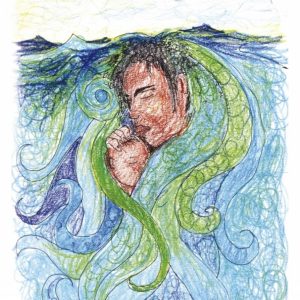
Story:
This image of a mother cradling her baby is heartbreakingly lovely—or at least it is until we realize that they are under the waves. Then it is just heartbreaking.
The tragedy that took their lives and the lives of at least 366 others took place just off the shores of the island of Lampedusa in the Mediterranean Sea on October 3, 2013. Over 500 people were crammed onto the rickety boat that caught fire and capsized that night. They were trying to escape war and poverty in places like Eritrea and Somalia.
We don’t know the names of the woman and child in Francesco Piobbichi’s picture. But he drew the picture so that we would not forget their story. Here is how he describes it in words:
On a moonless night, a boat with hundreds of passengers sank just off the coast of
Lampedusa. They asked for help but in vain. Hundreds of people perished at sea.
A baby was born at sea that night and then died without ever having seen the day
or smelled the sweet smell of land. The present sank without giving possibility for the
future to be born…” (Drawings from the Border, Claudiana, p. 21).
Bible Reading: Jeremiah 31:15 (NRSV)
“A voice is heard in Ramah,” the prophet Jeremiah writes. It is a voice of “lamentation and bitter weeping.” The matriarch, Rachel, is “weeping for her children” who have been killed or driven into exile. She “refuses to be comforted for her children, because they are no more” (Jer. 31:15).
Although the circumstances of our contemporary exiles are not precisely the same, it is hard not to hear mother Rachel weeping still. What else can one do but weep?
Believe it or not, some seek to blame the victims. “Why would a woman in the last stages of pregnancy try to cross the Mediterranean in a crowded boat? Why would she leave home in the first place?” they ask. These questions are ignorant of the desperation that drives migrants to leave their homes in the first place. They also overlook the fact that many women are raped along the way, and held for months in brutal Libyan “detention centers.”
Rachel is right. Weeping is the appropriate response. But it is not the only response. In a radio broadcast commemorating the anniversary of the October 3 event, Paolo Naso, the coordinator of Mediterranean Hope suggested that–
The only way to commemorate the victims of immigration should be the commitment
to stop this tragedy with laws and programs that allow safe and legal journeys to those
who have been fleeing war, persecution, hunger, and violence.
Weeping is natural. Blaming is inappropriate. But working for change is imperative.
Discussion/Reflection:
- The loss of life on October 3, 2013 is often described as a tragedy. In what ways is that word inadequate? In what sense might it better be labeled a crime?
- Describe your response to Piobbichi’s portrait? Are you drawn to it? Repelled by it? Why? What do you think of the portrait’s nickname: The Madonna of the Mediterranean?
Action:
- Read an early report of the October 3, 2013 tragedy as reported by the New York Times: Migrants Die as Burning Boat Capsizes Off Italy
- Take one concrete step to make the world safer for those who are vulnerable. To make a donation that will support ecumenical efforts to help refugees cross the Mediterranean safely, go to the Donation Page for Mediterranean Hope.
Prayer: Forgive us when we are tempted to look away from problems that seem too big to fix. Help us to find real ways to help. And lest we pray only for ourselves when the suffering of others is so great—stretch out your hands to comfort, to heal, and to save.
Welcoming the Stranger Series
In the last ten years more than 35,000 asylum seekers have died in the Mediterranean. Desperate to escape untenable situations in countries like, Syria, Eritrea, Sudan, and Somalia, refugees risk both life and livelihood to board rickety boats bound for what they hope will be a new life in Europe. Many of them die within sight of what they hoped would be the promised land.
Welcoming the Stranger is a devotional series designed to help Christians connect this unfolding humanitarian crisis in the Mediterranean with the Bible’s call to “welcome the stranger.” Recognizing that “the stranger” can sometimes be an abstraction that blinds us to the face of Christ, the series approaches the refugee crisis from a personal perspective. Each entry focuses on one person’s story, brought vividly to life by Italian artist and relief worker, Francesco Piobbichi. These stories are then linked to relevant Scripture, prayer, discussion, and action prompts.
Immigration is a hot topic around the globe, and the Bible passages in this series speak to wherever we are called to “welcome the stranger.” My specific interest in the Mediterranean context was sparked by a 2016 trip to the island of Lampedusa—a small island off the coast of Sicily that is the scene of so much hope and tragedy for refugees trying to enter Europe via small, unsafe boats. In addition learning about the situation there and the work being done by ecumenical groups like Mediterranean Hope, I spent significant time interviewing Francesco Piobbichi, whose art documents the stories of individual refugees and families who often die trying to reach safety. You can learn more about him and work through the following link: Francesco Piobbichi’s Artwork Each of his “snapshots” tells a story—sometimes of triumph, but often of tragedy: Piobbichi’s goal is to help people understand this large-scale human tragedy on a more personal level. My goal in this series is to use Piobbichi’s art as a starting point for Bible study and personal reflection/action.
